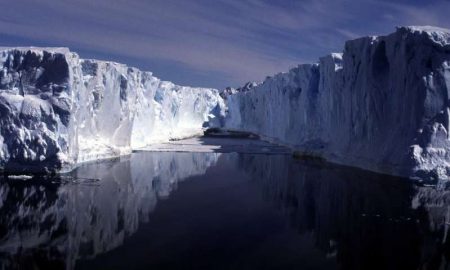December 14, 2016 – A paleoclimatologist from the University of Cambridge with colleagues from the USA, New Zealand, and Germany, have published this week in the journal Nature a new study of Antarctica’s climate history over the past 8,000 years. It may explain why sea ice in the Southern Ocean has overall increased in recent years despite pervasive global warming.
In the paper, the authors argue that climate modeling has failed to explain long phases of enhanced and reduced Antarctic ice mass and the impact this has had on overall climate variability.
“There is a natural variability in the deeper part of the ocean adjacent to the Antarctic Ice Sheet that causes small but significant changes in temperatures,” states Andreas Schmittner, Oregon State University. “When the ocean temperatures warm, it causes more direct melting of the ice sheet below the surface, and it increases the number of icebergs that calve off the ice sheet.” The combination causes a significant amount of freshwater to enter the Southern Ocean during warmer periods. As in paleoclimate studies of the past history of North America and the North Atlantic where sudden influxes of freshwater led to surface cooling of the ocean causing disruptive changes to the climate of Europe, the Southern Ocean phenomenon surface cooling produces a similar outcome. But the isolation of Antarctica completely surrounded by the ocean just causes the water to freeze. Hence increasing sea ice even when there are warmer temperatures both in the air and in the seawater to depths of hundreds of meters.
But there is another phenomenon previously not fully understood that is directly linked to the increased calving of icebergs from Antarctica’s ice shelves. States Nick Golledge, University of Wellington, “What is less-known is that the input of fresh water also leads to changes far away in the northern hemisphere, because it disrupts part of the global ocean circulation…..Meltwater from the Antarctic won’t just raise global sea level, but might also amplify climate changes around the world. Some parts of the North Atlantic may end up with warmer temperatures as a consequence of part of Antarctica melting.”
In another Antarctic study of sea ice history over the last century, it shows that the Southern Ocean has experienced very little change in ice volume from the time of Ernest Shackleton and others voyages of discovery in the late 19th and early 20th century. That research appears in a November edition of Cryosphere. Now there is a consistent explanation for this phenomenon. Sea ice is being rejuvenated because volumes of freshwater from calving icebergs caused by overall global warming are releasing significant amounts of freshwater as they melt in the Southern Ocean. And the icebergs of Antarctica make Arctic icebergs look like pop guns compared to howitzers. Many are tens of thousands square kilometers, bigger than many Pacific and Atlantic islands. Thus the ocean in proximity to Antarctica is not experiencing the same pattern we see in the Arctic where sea ice minimums appear to be setting new records annually.
Previous paleoclimate studies of the Antarctic done by members of the team writing this latest paper appearing in Nature have described a record of ice sheet collapses from the end of the last Ice Age lasting 10,000 years. Since then Antarctica’s pattern has remained in steady-state until recent history where we are witnessing increased calving and ice shelf collapses in the Antarctic Peninsula which I have written about and posted to this blog site.










